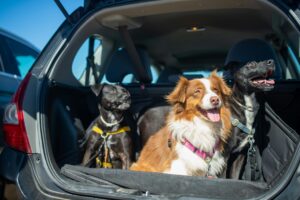Why Do Dogs Cry In The Car ?

Why Do Dogs Cry In The Car :- Many canines adore car rides, but the joy can quickly turn into whines, especially if they suspect a trip to the dreaded vet. While some pups eagerly jump into any vehicle, others whimper with anxiety.
If your furry friend whines during rides, it’s essential to decode their signals. Whether it’s excitement, nervousness, or a fear of the vet’s office looming ahead, understanding their whines can enhance both their comfort and your journey.
So, why do dogs whine in cars? It could be due to a myriad of reasons – from excitement to unease, or even feeling under the weather. By observing your dog’s cues and body language, you can decipher whether it’s fear or happiness prompting their vocalizations.
Curious about your canine’s car whining? Delve deeper to uncover the underlying reasons and make your next ride a smoother, more enjoyable experience for both of you.
Why Do Dogs Cry In The Car What’s Behind a Dog’s Whiny Behavior?
Dogs express themselves through whining for a multitude of reasons, each telling a unique tale. Deciphering these whines is key to ensuring a peaceful journey with your beloved pup. Here are the five primary reasons your furry friend might be vocalizing:

- Craving attention: Some dogs whine out of sheer excitement upon seeing their beloved pet parent, seeking attention and affection.
- Stress or fear: Anxiety often manifests with nervous pacing, while fearful dogs may whine, tremble, and seek refuge, signaling their discomfort.
- Alerting to something: Whether it’s a call for a bathroom break or a warning about a potential threat, your dog’s whining could be a crucial message you shouldn’t ignore.
- Overflowing excitement: Whining, coupled with behaviors like jumping and yipping, signifies your dog’s eagerness or agitation, whether about entering the car or embarking on an adventure.
- Pain or discomfort: Keep an eye out for signs of injury or illness, especially if accompanied by excessive drooling. Car sickness could also be a culprit, warranting a vet visit for suitable remedies.
Understanding your dog’s whines, alongside their energy and body language, is vital. It’s their way of communicating their heightened emotional or physical state, emphasizing the importance of attentive listening and response.
Why Do Dogs Cry In The Car How to calm my dog in the car?
Now that we’ve explored the myriad reasons behind canine car ride woes, let’s delve into strategies to ease your furry friend’s discomfort:
- Ease into it: For pups unaccustomed to car rides, start with short jaunts around the neighborhood, gradually extending the duration and frequency. This gradual exposure helps acclimate them and minimizes anxiety.
- Craft a cozy space: Ensure your dog has a snug spot to settle during the journey. Utilize a crate or a dog seatbelt to provide security and alleviate motion sickness. Bringing along their cherished toy or blanket can also offer familiar comfort.
- Embrace positive reinforcement: Encourage calm behavior by rewarding your dog with treats, praise, or their favorite toy during car rides. This positive association helps quell anxiety and fosters a sense of ease.
- Seek professional guidance: If your dog struggles significantly with motion sickness or anxiety, consult with your veterinarian. They can offer tailored solutions, such as medication or behavioral interventions, to enhance your pup’s comfort and well-being.

By implementing these strategies, you can transform car rides from a source of stress to a pleasurable adventure for both you and your cherished canine companion.
YOUR DOG IS EXCITED TO BE IN THE CAR!
Dogs express themselves through cries and whines, not just when upset, but also when brimming with excitement! If they link car rides with joyous adventures or anticipate a thrilling destination, their cries might stem from sheer excitement. Look for accompanying signs of happiness like a wagging tail, relaxed mouth, and alert ears, indicating a contented pooch.
While joyous cries are heartwarming, continuous whining can grate on your nerves. To curb this behavior, positive reinforcement is key. Reward your dog when they exhibit desired behavior, such as calmness, with treats (assuming you’re not driving) and attention. Ignore their whines during the journey, refraining from rewarding them with treats or attention until they’ve settled down. Persistence is key, as this training method may take time depending on the frequency of car rides and the severity of the issue.
Ensuring your dog gets ample exercise and has an outlet for their energy can also mitigate excited crying. A brisk walk or play session prior to car rides can help dissipate excess energy, fostering a serene and composed canine companion.
Safety Tips for Traveling With Your Dog
When embarking on a journey with your furry companion in the car, it’s essential to prioritize safety and comfort for both you and your canine co-pilot. Here’s a spin on some tips to ensure a smoother and safer ride:

- Create a Cozy Haven: Transform your car into a haven of comfort and security for your dog by using a crate. This not only keeps your pooch calm but also ensures their safety during the journey.
- Identify Your Furry Traveler: Equip your dog with proper identification tags to facilitate a swift reunion in case they wander off. A well-tagged collar or microchip can be a lifesaver if your furry friend decides to explore.
- Establish Boundaries: Install a sturdy barrier to confine your dog to the back seat. This prevents them from wandering into the front area, reducing distractions and enhancing your focus on the road ahead.
- Frequent Pit Stops: Break up the journey with regular stops to offer your dog hydration and bathroom breaks. Keeping your furry friend comfortable and refreshed ensures a more enjoyable travel experience for everyone involved.
- Leash Up for Safety: Keep your dog securely tethered with a leash whenever you’re on the move. Additionally, consider using a specialized dog seat belt to provide an extra layer of protection while traveling in the car.
By implementing these safety measures, you can embark on your travels with peace of mind, knowing that you and your beloved canine companion are well-prepared for the road ahead. Safe travels!




